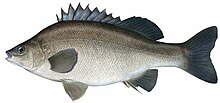銀鋸眶鯻
銀鋸眶鯻(學名:Bidyanus bidyanus、英語:Silver Perch),又稱銀鱸[2]或澳洲银鲈[3],為鱸形目鱸亞目鯻科的一種魚類,是澳洲墨累—大令盆地底中層水域的特有種[4][5],被IUCN列為易危物種[1]。
| 銀鋸眶鯻 | |
|---|---|

| |
| 科学分类 | |
| 界: | 动物界 Animalia |
| 门: | 脊索动物门 Chordata |
| 纲: | 辐鳍鱼綱 Actinopteri |
| 目: | 鲈形目 Perciformes |
| 科: | 鯻科 Terapontidae |
| 属: | 鋸眶鯻屬 Bidyanus |
| 种: | 銀鋸眶鯻 B. bidyanus
|
| 二名法 | |
| Bidyanus bidyanus Mitchell, 1838
| |
| 異名 | |
| |
外形 编辑
銀鋸眶鯻體延長而側扁,高度中等,頭小、眼小,吻尖,背部褐色至深灰色,體側為銀灰色,腹部銀白色,背鰭及尾鰭黑色,臀鰭白色,體長多為30-40公分,體重約1.5公斤,但亦有體長超過60公分、體重接近8公斤的紀錄,是鯻科體型最大的魚類。[6][7]
分類 编辑
銀鋸眶鯻於1832年由澳洲探險家湯瑪斯·米謝爾探索巴望河時紀錄發表,其學名來自當地原住民對這種魚的稱呼「Bidyan」[5]。銀鋸眶鯻的英文俗名雖為「Silver Perch」,但其屬於鯻科,並非鱸屬(Perca)的成員。
生態 编辑
成魚棲息在水流快速的溪流、水庫及湖泊,成群活動,屬雜食性,以水生昆蟲、軟體動物、蠕蟲、藻類等為食[4][8],會進行季性洄游,繁殖期為11月至隔年1月,成魚於黃昏或夜間在接近表面的水域交配,雌魚可一次產50萬顆漂浮卵,卵在水流不明顯時會沉入水中。水溫攝氏26-27度時,其卵於24-36小時後孵化,不過其卵能孵化的溫度範圍較廣,有記錄顯示在攝氏20度以下的低溫仍可孵化,但所需時間較久[4]。
過去認為銀鋸眶鯻和澳洲東南部其他原生種魚類一樣相當長壽,此特徵可以確保其成魚在當地嚴峻的環境中,一生至少可以經歷一次特別適合產卵的季節(通常是每10-20年發生一次、造成當地特別潮濕的強烈反聖嬰現象)[4][6][8],曾有27歲的個體被紀錄[7]。不過2017年的一項研究顯示銀鋸眶鯻族群中,只有少部分個體能存活超過7年,因此若連續幾年的氣候都不適合繁殖,其族群就會面臨嚴重危機[9]。
經濟利用 编辑
保育 编辑
銀鋸眶鯻於1970年代前廣泛分布於墨累河、達令河流域,然而之後由於不明的原因,野外的族群大量消失,目前僅墨累河的族群數量較多,雖然人工養殖的數量及範圍增加,然其對於該物種的保育的成效並不佳。經研究其數量減少的原因可能是因爲水壩的興建,導致魚群無法進行洄游,又其魚卵須沉澱在含氧量高的沉積物上,然水壩的調節水量功能,致使魚卵因沉積物掩埋、缺氧而死亡[4][8]。另外,外來種魚類(如鯉魚)的入侵和傳染疾病(如EHN病毒)亦為導致銀鋸眶鯻數量減少的原因[11][12]。自2000年起,墨累河的許多壩堰建立了魚道,使當地原生魚類得以洄游,加上環境流量的管理,使銀鋸眶鯻的野外族群開始復甦[4]。
參考文獻 编辑
| 維基物種上的相關信息:銀鋸眶鯻 |
- ^ 1.0 1.1 Wager, R. Bidyanus bidyanus. IUCN Red List of Threatened Species (IUCN). 1996, 1996: e.T2804A9482704 [6 September 2016]. (原始内容存档于2019-07-01).
- ^ 銀鱸. 雙語詞彙、學術名詞暨辭書資訊網. 國家教育研究院. [2018-10-30]. (原始内容存档于2018-11-08).
- ^ 澳州银鲈生物学特性及其养殖技术--中国数字科技馆. www.cdstm.cn. [2024-02-20]. (原始内容存档于2024-02-20).
- ^ 4.0 4.1 4.2 4.3 4.4 4.5 Australian Government Conservation Advice for Silver Perch (PDF). Australian Government - Department of the Environment and Energy. 2013 [2018-10-30]. (原始内容存档 (PDF)于2017-03-17).
- ^ 5.0 5.1 Mitchell, Thomas. Three Expeditions into the Interior of Eastern Australia; with Descriptions of the Recently Explored Region of Australia Felix, and of the Present Colony of New South Wales 2nd. London: T. and W. Boone. 1838 [2018-10-29]. (原始内容存档于2018-09-05).
- ^ 6.0 6.1 Silver Perch (Bidyanus bidyanus) NSW Recovery Plan (PDF). NSW Department of Primary Industries. 2006 [7 September 2016]. (原始内容 (PDF)存档于2018-11-08).
- ^ 7.0 7.1 Mallen-Cooper, Martin; Stuart, Ivor G. Age, growth and non-flood recruitment of two potamodromous fishes in a large semi-arid/temperate river system. River Research and Applications. 2003, 19 (7) [7 September 2016]. doi:10.1002/rra.714. (原始内容存档于2017-03-24).
- ^ 8.0 8.1 8.2 Clunie, Pam; Koehn, John D. Silver Perch: A Resource Document (报告). Murray-Darling Basin Commission:Canberra. 2001 [7 September 2016]. (原始内容存档于2018-10-30).
- ^ Research prompts new approach to supporting silver perch. Murray-Darling Basin Authority. [2018-10-30]. (原始内容存档于2018-07-12).
- ^ Bidyanus bidyanus (Mitchell, 1838). Fishbase. [2018-10-30]. (原始内容存档于2018-10-30).
- ^ Impacts of weirs on downstream passage of native fish in the Murray-Darling Basin. Finterest. 2013 [7 September 2016]. (原始内容存档于2018-10-29).
- ^ Boys, CA; Baumgartner, L; Robinson, W; Lay, C. Protecting migrating fish at in-stream structures: downstream mortality at weirs and screening water diversions (PDF). Murray Darling Basin Authority. 2010 [7 September 2016]. (原始内容 (PDF)存档于15 July 2012).
